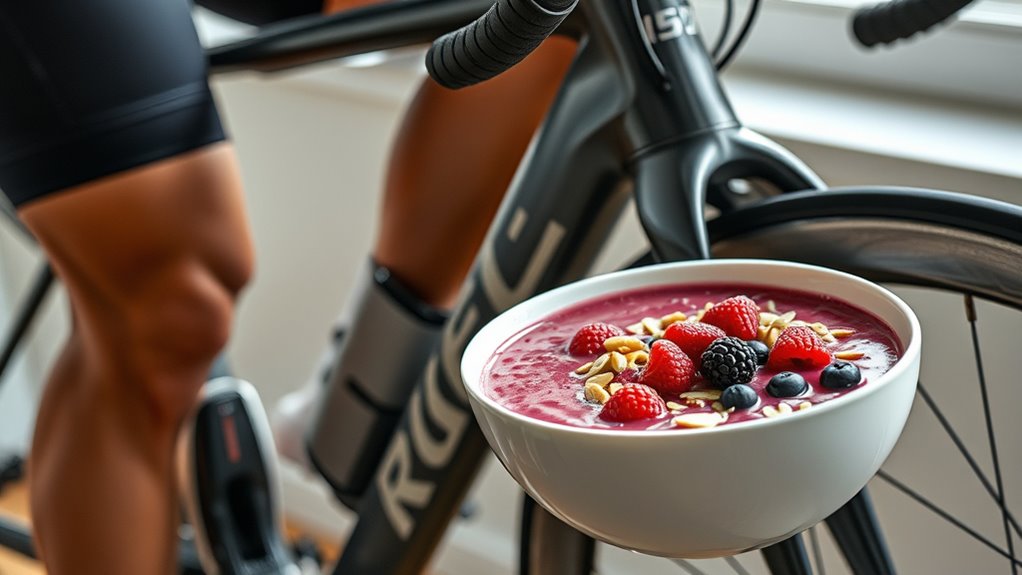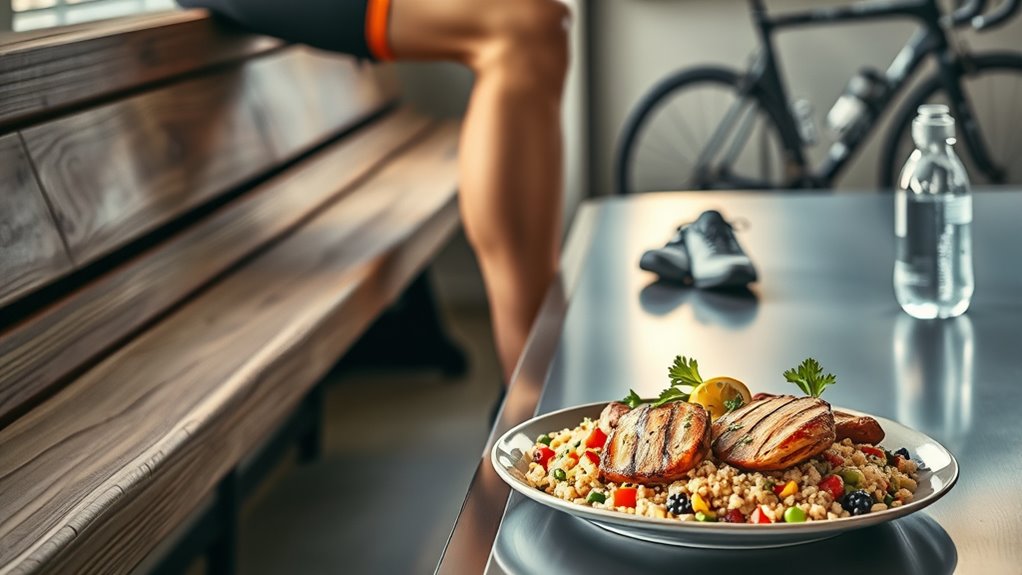To optimize your recovery as a cyclist, guarantee you’re getting enough high-quality protein from sources like lean meats, dairy, or plant options. Timing matters—consume carbs and protein together within 30-60 minutes post-ride to replenish glycogen stores and promote muscle repair. Spreading your protein intake evenly across meals helps maintain steady recovery. If you want to discover more about how strategic nutrition can boost your cycling performance, keep exploring the essential tips.
Key Takeaways
- Consuming high-quality protein post-ride supports muscle repair and reduces recovery time.
- Evenly distribute protein intake throughout the day to maintain continuous muscle recovery.
- Pairing protein with carbohydrates after cycling enhances glycogen replenishment and muscle healing.
- Adequate protein intake minimizes soreness and inflammation, helping cyclists return stronger.
- Prioritizing protein sources like lean meats, dairy, and plant-based options optimizes recovery efficiency.

Proper recovery is vital for cyclists looking to improve performance and prevent injury, and nutrition plays a key role in this process. When it comes to recovery, fueling your body with the right nutrients can make a significant difference. Protein is crucial for muscle repair, helping your muscles recover and grow stronger after grueling rides. Without adequate protein intake, your muscles may take longer to heal, increasing the risk of soreness and injury. Incorporating high-quality protein sources like lean meats, dairy, eggs, or plant-based options ensures your body has the amino acids needed for effective muscle repair.
Timing your carbohydrate intake is equally important. After a ride, your muscles are depleted of glycogen, the stored form of carbohydrate in your muscles. Consuming carbohydrates shortly after exercise helps replenish these stores, which is vital for recovery and preparing your body for the next ride. This process, known as carbohydrate timing, involves eating carbs within a specific window—usually within 30 to 60 minutes post-ride—to maximize glycogen synthesis. Combining carbs with protein during this window enhances recovery even further, as research shows that the duo promotes better muscle repair and decreases soreness.
You should aim to include a source of protein along with your post-ride carbs to support muscle repair. For example, a protein shake with fruit, Greek yogurt with honey, or a turkey sandwich can be effective options. Consuming protein soon after your ride ensures that your muscles receive the amino acids they need to repair torn fibers and reduce inflammation. This not only accelerates recovery but also helps you come back stronger for your next ride.
In addition to post-ride nutrition, maintaining a consistent intake of protein throughout the day supports ongoing muscle repair. Spread your protein intake evenly across meals and snacks to keep amino acids available in your bloodstream, aiding continuous recovery. Remember, your body’s ability to repair muscles is optimized when you align your carbohydrate intake with your activity levels. Proper carbohydrate timing, combined with sufficient protein, ensures your muscles are replenished and repaired efficiently, reducing fatigue and improving overall cycling performance. Furthermore, ongoing research into AI safety emphasizes the importance of monitoring and developing safety measures, which can be paralleled to ensuring consistent and safe recovery strategies in athletic nutrition.
Frequently Asked Questions
How Does Protein Intake Affect Cycling Performance?
Your protein intake directly impacts your cycling performance by promoting muscle synthesis and aiding energy restoration. When you consume enough protein, your muscles recover faster from intense rides and stay stronger. This improved recovery means you can train more effectively and reduce fatigue. Consistently fueling your body with adequate protein helps maintain endurance, boosts overall performance, and keeps you riding at your best longer.
What Are the Best Protein Sources for Cyclists?
Powerful plant-based proteins pack a punch for cyclists seeking sustainable strength. Think tempting tofu, lively lentils, or hearty hummus—easy to digest and deliciously diverse. These plant options promote quick protein digestion, fueling your rides and aiding recovery. Incorporate a variety of pulses, grains, and nuts into your diet to optimize muscle repair and replenish energy. With these plant-based picks, you’ll push further and recover faster, feeling energized after every ride.
How Much Protein Should a Cyclist Consume Daily?
You should aim for about 1.2 to 2.0 grams of protein per kilogram of body weight daily, depending on your training intensity. Time your protein intake around your rides and meals to optimize recovery. Combine this with proper hydration strategies to support muscle repair and reduce fatigue. Spread your protein consumption evenly throughout the day, especially after workouts, to maximize benefits and keep your energy levels steady.
When Is the Optimal Time to Consume Protein After Cycling?
Think of post-ride nutrition as fueling your engine after a long journey. You should consume protein within 30 to 60 minutes, like refueling at a pit stop, to optimize muscle repair timing. This window is vital; it guarantees your muscles get the nutrients they need to recover quickly and effectively. Don’t wait too long—acting promptly helps your body rebuild stronger, ready for your next ride.
Can Excessive Protein Intake Harm Cyclists’ Health?
Yes, excessive protein intake can harm your health. Overloading on protein slows digestion and can strain your kidneys, potentially leading to kidney issues over time. You might experience dehydration, fatigue, or digestive discomfort. To stay safe, balance your intake and avoid consuming far more than your body needs. Proper protein digestion is vital for recovery, but moderation ensures your kidney health stays protected.
Conclusion
Think of protein as the fuel that mends your bike after a long ride—patching up worn parts so you can hit the road again. When you prioritize protein intake, you’re planting seeds for a strong, resilient body that recovers like a well-oiled machine. With each meal, you’re building a fortress of strength, ready to conquer the next hill. Keep fueling right, and your recovery will be the steady tide lifting you back to peak performance.









